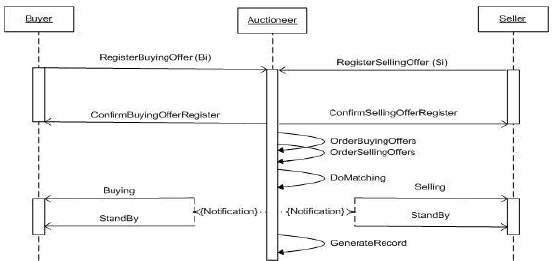Serviços Personalizados
Journal
Artigo
Indicadores
-
 Citado por SciELO
Citado por SciELO -
 Acessos
Acessos
Links relacionados
-
 Citado por Google
Citado por Google -
 Similares em
SciELO
Similares em
SciELO -
 Similares em Google
Similares em Google
Compartilhar
DYNA
versão impressa ISSN 0012-7353versão On-line ISSN 2346-2183
Dyna rev.fac.nac.minas v.77 n.163 Medellín jul./set. 2010
MODELING OF INVESTMENT STRATEGIES IN STOCKS MARKETS: AN APPROACH FROM MULTI AGENT BASED SIMULATION AND FUZZY LOGIC
MODELACIÓN DE ESTRATEGIAS DE INVERSIÓN EN MERCADOS BURSÁTILES: UN ENFOQUE DESDE LA SIMULACIÓN BASADA EN SISTEMAS MULTI AGENTE Y LA LÓGICA DIFUSA
ALEJANDRO ESCOBAR
Department of Systems Engineering, School of Mines, National University of Colombia , aescobag@unal.edu.co
JULIÁN MORENO
Department of Systems Engineering, School of Mines, National University of Colombia , jmoreno1@unal.edu.co
SEBASTIÁN MÚNERA
Department of Systems Engineering, School of Mines, National University of Colombia , sfmunera@unal.edu.co
Received for review August 21th, 2009, accepted June 16th, 2010, final version July, 16th, 2010
RESUMEN: Este artículo presenta un modelo de simulación de un sistema complejo, en este caso un mercado financiero, usando el enfoque de la Simulación Basada en Sistemas Multi-Agente. Este modelo toma en cuenta aspectos a nivel micro como el mecanismo de Subasta de Doble Punta Continua, el cual es ampliamente utilizado en mercados bursátiles, así como el razonamiento de los agentes inversores quienes participan en ellos en búsqueda de ganancias. Para el modelamiento de este razonamiento se consideraron muchas variables, incluyendo información general de las acciones como rentabilidad y volatilidad, pero también aspectos propios de los agentes como su propensión al riesgo. Todas estas variables son incorporadas mediante el enfoque de Lógica Difusa para así intentar representar de cierta manera el tipo de razonamiento que tienen los inversores inexpertos, incluyendo un componente estocástico para modelar factores humanos.
PALABRAS CLAVE: MABS, Mercado Bursátil, Subasta de Doble Punta Continua, Lógica Difusa.
ABSTRACT: This paper presents a simulation model of a complex system, in this case a financial market, using a Multi-Agent Based Simulation approach. Such model takes into account micro-level aspects like the Continuous Double Auction mechanism, which is widely used within stock markets, as well as investor agents reasoning who participate looking for profits. To model such reasoning several variables were considered including general stocks information like profitability and volatility, but also some agent's aspects like their risk tendency. All these variables are incorporated throughout a fuzzy logic approach trying to represent in a faithful manner the kind of reasoning that non-expert investors have, including a stochastic component in order to model human factors.
KEYWORDS: MABS, Stock Market, Continuous Double Auction, Fuzzy Logic.
1. INTRODUCTION
During the past decades a new research field, which consists in representing complex interactions among some entities called agents, has emerged and may be seen as a convergence of two apparently different approaches: Agent-Based Social Simulation (ABSS) [1] and Multi-
Agent Systems (MAS) [2]. The former belongs to the intersection of social, mathematical and computer sciences, and is defined as the simulation of social phenomena using computational resources. On the other hand, MAS is categorized within Artificial Intelligence and may be described as the design of software agents whose objective is to reach a goal taking into account certain rules, and that can be provided with elaborated behaviors and rationality. Both fields have been forged together to form what is called Multi-Agent Based Simulation (MABS) [3, 4], which aims to simulate complex systems from the micro-level view point, focused on the interactions among agents as representations of human or social actors, and takes into account the methodology for modeling the agents architecture and behaviors.
One clear example of what a complex system is, and thus good candidate to be modeled with MABS, are the stock markets that usually operate using a Double Auction mechanism. Such markets are made up of heterogeneous participants that interact among themselves in a very dynamic manner. Participants may differ in their strategies and individual features, and the interaction among them is affected by and affects the environment (due to offer and demand forces). These characteristics are not usually considered in traditional approaches or have been analyzed in a very constrained way generalizing some aspects. In particular, it was usually assumed that involved agents are homogeneous and have very simple behaviors. These assumptions only work on ideal systems where all the participants have similar thoughts and have no real individual desires and conditions, which is certainly not true in real life.
Considering this, a Multi-Agent Based Simulation of a stock market is presented in this paper taking into account two micro level aspects. First, the Continuous Double Auction was modeled as the transaction mechanism which allows simulating individual orders matching and, as consequence of the sum of them, the offer and demand forces. Second, each market participant was modeled as an agent having its own behavior. This work focuses on investor agents with no financial knowledge whose reasoning is based on general stocks information but that is altered by their risk profile as well as by external factors. To model how all these factors affects agents' decisions we propose a Fuzzy Logic approach trying to represent as faithfully as possible their real human counterpart.
The remainder of this paper is organized as follows: Section 2 presents a brief description of some related works; Section 3 presents an overview of the Double Auction process followed by the description of the proposed model in Section 4. The results of a validation case are analyzed in Section 5 and, in the end, some concluding remarks are presented in Section 6.
2. RELATED WORKS
MABS along with inference mechanisms to model trader decisions, have been used in several works in order to analyze financial market evolution as well as agents behaviors. In [5] for instance, a model with heterogeneous interacting traders modeled with agents which can explain some of the stylized facts of stock market returns is proposed.
In [6] authors propose a double auction artificial market populated by heterogeneous agents who trade one risky asset in exchange for cash. Those agents issue random orders subject to budget constraints and the limit prices of orders depend on past market volatility.
An agent-based stock market simulation in which traders utilize a hybrid mixture of common information criteria based inference procedures, is presented in [7]. Traders in this work compete with each other using a range of different inference techniques to infer the parameters and appropriate order of simple autoregressive models of stock price evolution.
In [8] a MABS approach is used to analyze how asset prices are affected by investors and investment systems that are based on behavioral finance. In order to do that, they build a virtual financial market that contains two types of investors: fundamentalists and non-fundamentalists, analyzing how each one affect traded prices.
A lot of other works could be included in this section, some of them are presented in [9 - 11]. They all share the micro level approach to model markets but differentiate in the way they model participants. Precisely this issue is the main contribution of the work presented in this paper because uses a novel approach, fuzzy logic, with the aim of analyze the performance of non expert traders influenced by subjective factors.
3. DOUBLE AUCTION
In recent years, electronic commerce has become an important way to negotiate goods in many business fields including financial markets where participants may be distributed in many locations around the world so having them together in a single physical place is not feasible. The usual way to perform transactions on these markets is through auctions which define protocols that buyers and sellers must follow in order to complete a transaction. In general, there are two kinds of auctions: One sided auctions and two sided auctions or double auctions. In the former case there is a good that somebody wants to sell and an auctioneer who is in charge of receiving offers of potential buyers and determining the winner. There are several variations of this kind of auction, e.g., Dutch auction, English auction, among others. In the two sided auctions both, buyers and sellers, are active part of the protocol because they send their respective sell and buy orders or offers to a common board where anyone can see anyone else's orders and the auctioneer just matches them.
There are two kinds of double auction: In a Discrete Double Auction there is an established time to receive all buy and sell orders, every certain time inside this period, the auctioneer proceeds to make the matching process according to the orders prices. On the other hand, in the Continuous Double Auction (CDA) there is also a fixed time to receive orders, but the matching process is verified each time a new offer arrives. In other words, the auctioneer compares every incoming order with the queue of orders that have previously arrived and have not been matched. In both cases, when an order matches with any of the open orders in terms of price and quantity of a good, a trade is executed and seller and buyer are notified about the transaction [12].
The work presented in this paper uses the Continuous Double Auction for specifying the transaction process of buyers and sellers inside a stock market, and it is not formally defined and presented here because it is beyond the scope of this paper. An explanation of the detailed process of a Double Auction operation can be found at [13, 14], where the protocol is mathematically defined by specifying equations and steps of the protocol algorithm.
4. PROPOSED MODEL
In order to describe the proposed simulation model, three main issues are considered in this section. First, the general Multi-Agent structure; second, the modeling of the agents reasoning; and finally, the implementation details.
4.1 Multi Agent SystemThe Multi-Agent System - MAS that supports this proposal was modeled using the Sigma methodology [15] which is particular for MABS models and considers the generic phases of conceptualization, analysis and design, and proposes some models for the later phases of implementation and verification, validation, results study and replication. The use of this methodology is explained in [16] and is not described in detail here because it is beyond the scope of this paper. Instead the main features of the modeled agents and their interaction are described in this section.
Basically, there are three kinds of agents that were modeled, namely investor, auctioneer and market. The investor agent represents the participants who want to trade a given good in the market that is being modeled in order to obtain profits. Such market is managed by the auctioneer agent who is in charge of the Double Auction mechanism and informing transactions. Market is an additional agent that represents a conglomerate (the rest of the market besides the investor agents) and it is used to simulate part of offer and demand forces of the modeled market, as well as prices evolution. The reason of the existence of this agent is that, as in the proposed model there are a limited number of investor agents (not necessarily as much as in a real market), the system would not be very realistic because in real markets there are external factors that affect the behavior of the agents as well as the market itself. These external
factors are represented within the market agent using the standard geometric Brownian motion model that basically generates synthetic time series for the stock prices according to the historic values that are used to feed the simulation. In each simulation period, a price is generated for each stock, and buying and selling orders are sent in a random ±5% range of such a price.
For a specific simulation there would be only one instance of the auctioneer agent, one of the market agent and as many as wanted investor agents. The latter two may take the role of buyer and/or seller whereas the former leads the protocol. An auction process begins when the participants (investors and market) register themselves to the auctioneer, when registration time is finished the auctioneer sends to all the registered participants an advertisement of auction start, after this, all participants may make buy and sell orders. There is a time limit to send offers, during this time as the auctioneer receives orders immediately applies the CDA algorithm and sends confirmation of the order reception followed by a notification: when he finds a match between a couple of orders, he notifies the involved traders and updates the orders queue, if no order is matched he sends a stand by notification. When the auction time is finished the auctioneer sends to all the participants an advertisement of auction end and no trader can send further orders. If there are more scheduled periods in the simulation the auctioneer sends a new auction start and the process is repeated. This process is represented through a message sequence diagram, as shown on Figure 1.
4.2 Agents reasoningFrom the three kinds of agents that were considered in the simulation model, this section focuses on investor agents because they must take complex decisions in order to increase their profits, whereas the other two agents, market and auctioneer, have more reactive behaviors as it was explained earlier. On real financial markets there are many profiles of investors. Some of them are big companies as banks, pension funds, etc., that put big amounts of money, usually taking conservative positions, in order to earn profits and pay interests to their clients; others are expert investors who use financial knowledge in order to earn profits for their own or for thirds; and there are also "non-expert investors" who are regular people that use these markets as an investment option directly or using stockbrokers. Some regular features of this last profile is that they do not invest big amounts of money, are short term investors (usually they do not perform intra day operations, neither wait many months or years to get their money back), and more important, they are rational in the sense that use some information of the market to make their decisions, but they also have some irrationality because are moved by human emotions and external factors. Precisely, this kind of investor is the one that is modeled in this proposal and, in order to do that, it was assumed that they incorporate in their decision making process market variables as well as personal factors. Among the market variables we shortened all possible options to two that we consider are easy to obtain and interpret: one related to the stocks profitability Ri (arithmetic mean of the logarithmic returns) and the other to their volatility Vi (their variance). The number of days used to calculate them is randomly different for each agent with the aim of giving them some sort of "subjectivity".
About the personal factors we considered one, the risk tendency, which somehow measures in a quantitative way how prone to risk these agents are. This variable was modeled as a continuous number between zero and one, where the least degree means that such agent is not prone to the risk at all, whereas one means that he is totally prone to the risk.
To incorporate these three variables into a model that represents agents reasoning a Fuzzy Logic - FL approach [17, 18] was chosen. This is an Artificial Intelligence technique which aims to represent knowledge in a similar way as humans do, using linguistic variables instead of mathematical ones. In contrast to classic sets logic, FL does not consider that the value of one variable belongs to just one set (certainty values are boolean), but to several with different membership degrees that go from zero (no membership at all) to one (complete membership). It means that sets boundaries in FL are not exclusive and that is why they are called fuzzy sets. For instance, in an industrial context, a boiler temperature may be modeled (covering the whole possible range) as: low, medium and high, all of them represented with fuzzy sets, and for instance a temperate value of 80°F may be low with a 0.2 membership value, medium with 0.7 and high with 0.3. Considering this, a Fuzzy Inference System - FIS may be expressed as a set of rules in the form IF (antecedents) THEN (consequents) where both, antecedents and consequents are defined as fuzzy sets.
In this work, two reasoning processes are modeled for investor agents using FIS, one for taking buying decisions and other one for selling decisions, both for the short term and using as inputs the three variables previously described. The fuzzy sets of the input variables for buying decision are presented on Figure 2, their numbers and shapes were determined using expert knowledge.
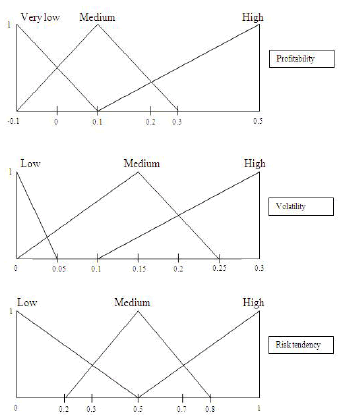
Figure 2. Fuzzy sets for buy reasoning
In order to incorporate human emotions and external factors into this decision, the output variable, rather than being a boolean value (buying or not buying), is a probability factor, in this case, for buying. This way if for instance the output is 0.9 for an agent in a determinate period and a determinate stock, that would mean that such agent would buy such stock in that period with a probability of 0.9. Fuzzy sets for this output variable are presented in Figure 3; in this case five homogeneous sets were defined in order to discriminate this value for different situations.
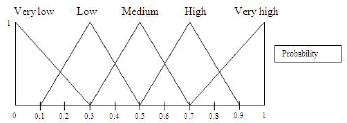
Figure 3. Fuzzy set for probability
Rules set for this inference system is presented on Table 1 where all the combinations of input variables and their corresponding output can be seen in a matrix structure, where each cell represent a IF . THEN . rule. For instance [R4] represents the rule "IF in determinate period, the profitability of a stock is low, its volatility is medium and the risk tendency of an agent is low, THEN the probability for such agent of buying that stock in that period is very low". In contrast for instance [R21] represents the rule "IF in determinate period, the profitability of a stock is high, its volatility is low and the risk tendency of an agent is high, THEN the probability for such agent of buying that stock in that period is very high".
Table 1. Inference rules for buying reasoning
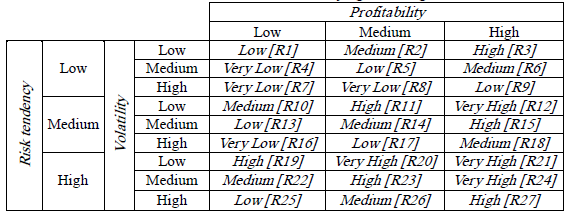
One way to see graphically the whole inference system is through fuzzy surfaces that are a 3D representation of the inputs-output relation. Figure 4 shows for instance how probability factor behaves with regard to stock profitability and volatility (for this figure risk tendency was fixed in 0.5). Here it can be seen that such output is directly proportional to stock profitability and inversely to its volatility as it would be expected. For this inference system, the risk tendency acts as some kind of multiplier in the sense that decreases output value for conservative investors and increases it for the ones who are more prone to risk.
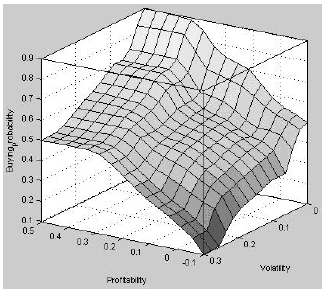
Figure 4. Fuzzy surface in buying reasoning
Now, for selling decision, even if stock profitability and volatility are also considered, the difference with regard to buying decision lies in that they are not measured in absolute values, but they are in function of their expected value (according to each agent). In this case, the input variable X1 is the relationship between profitability Ri obtained by an agent until the last period and the expected profitability RE in the short term as shown in (1). The former factor may vary as time passes, whereas the latter is calculated for each agent at the beginning of the simulation, when "enters" to the market, as the mean of the last k periods of this variable.
Values k and E are different for each agent to differentiate them.

The second input variable X2 is similar to X1, but it relates current volatility Vi and the expected volatility VE as shown in (2). In this case both factors are calculated in the same way than the ones in X1.

The fuzzy sets for these two input variables are presented on Figure 5, whereas for the risk tendency, due to its interpretation is equal than in buying decision, the same sets are used.
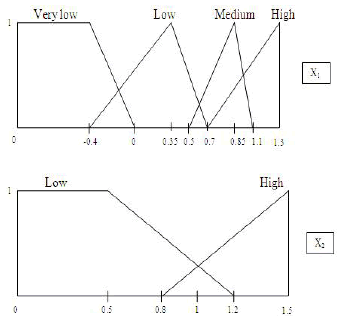
Figure 5. Fuzzy sets for sell reasoning
In this reasoning, the output variable is the probability of selling a determinate stock, and it was also modeled using the same fuzzy sets that were used in buying decision.
Rules set for this inference system is presented on Table 2 and the corresponding fuzzy surface is presented on Figure 6. However, as it can be seen in both, this time the decision is more complex and not necessarily proportional to all inputs. This is due to the fact that a selling decision may be caused by two different situations. The first one, and the one that any investor wants, is that the stock that he previously bought has increased its price reaching a certain expected value (which X1 models), in this case the investor may feel satisfied with the profit he earned so far, and decides to sell the stock.
Table 2. Inference rules for selling reasoning

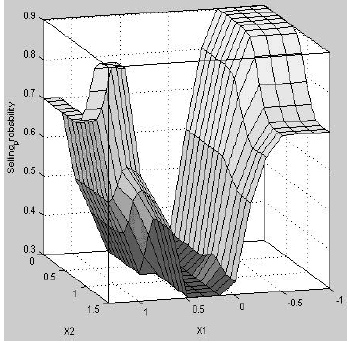
Figure 6. Fuzzy surface in selling reasoning
The second situation, the undesired one, is that the stock decreases its price or has not reached the expected value so investor prefers selling it before something worse happens. Until here, only stock profitability has been considered, but how volatility and risk tendency affect this decision? Well, in the case of volatility when it is low with regard to its historic values, an investor may hold on in his position a little longer in both situations (ups and downs). However when it is high, this could intimidate the investor in the first situation and calms him down in the second one. In the case of the risk tendency, it acts in a similar way than in buying decision but backwards, because increases output value for conservative investors and decreases it for the ones who are more prone to risk.
5. RESULTS
In order to validate the model presented in this paper a computational prototype was implemented according to the structure that was described in the previous section. Configuration data for such prototype includes: number of periods (days) to be simulated, number of investor agents and number of stocks. For each stock a unique name must be defined as well as the minimum amount that must be traded on each transaction, 1 is the default value, but a bigger number may be defined if such stock is traded by packages. Additionally, a historic record of volumes and prices must be entered for each stock as the initial information that agents consider. Such records may be loaded from a XML file with actual data, or may be simulated randomly according to some range that user defines. For each investor agent a unique name must be defined as well as the initial balance (available money) and the amount of each stock that he posses, 0 is the default value but a bigger number may be defined if user assumes that such agent is not new in the market. The risk tendency for each investor agent must also be defined, remembering that zero means that the agent is extremely adverse to risk, and one means that is extremely prone to risk.
Such prototype was validated by making several test cases (runs with different configurations), one of them is presented here. Such test case was defined for 100 periods, included two significant stocks of the Colombian stock market [19], ISA and EXITO and, for both, a historic 30 days record of volumes and prices was loaded. Five investor agents were defined and, for the sake of simplicity and comparative purposes, their initial balance and stocks amounts were defined equals.
Each of these agents differentiate from each other in their risk tendency in order to compare their behaviors and their corresponding results (values of 0.1, 0.3, 0.5, 0.7 and 0.9 were defined for investor agent a1, ., a5). Besides this variable, it is important to remember that particularities of each of these agents are also modeled with the values of k and E, which were described in the agents reasoning section. These variables were set randomly for each agent within the range [8, 24].
Once a simulation is run, the results may be observed graphically using the prototype interface that connects to the system database where results are saved. Figure 7 shows for example the stocks charts, where the mean price and volume for each period after performing all transactions with the CDA mechanism are presented, and a dotted line represents the border between historic data and simulation's results. Here it is important to note that decisions made by each agent every period do affect the stocks prices and volumes (in some proportion, whereas the rest is modeled through market agent), so system (the stock market) is self fed in the sense that investor agents incorporate this information for their decisions making processes. This figure also shows that simulation results seem to conserve mean and variance of prices and volumes with regard to historic values, so it may be concluded that stochastic models that are used within market agent, or at least its contribution to these variables formation, are adequate.
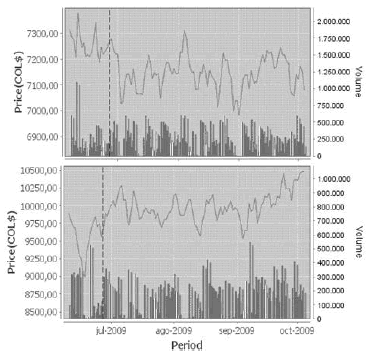
Figure 7. Price-Volume graphic for stocks ISA (top) and Exito (bottom)
Figure 8 shows the number of stocks that two of the defined agents had during each simulation period. These agents are a1 and a5, and were chosen for analysis purposes because they correspond to the ones with the smallest and greatest risk tendency, respectively. As it can be seen in this figure, the risk tendency affects the behavior of the agents and the way they reason when they make their buying and selling offers. In this case, this figure shows that a1 is very conservative, whereas a5 is more daring and takes more risks in both cases. For example, the a1's ISA stocks amount demonstrates that as this agent realizes that the price is going down he begins to sell it immediately in some proportion. Seeing the same situation a5 maintains steady, waiting for the price to go up. In both cases it is important to note that agents' behavior is not completely deterministic but has a probabilistic component that allows them to be more realistic.
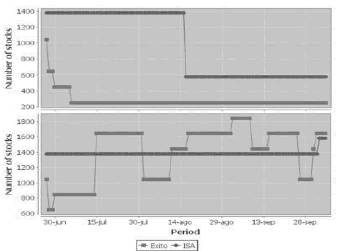
Figure 8. Stocks of the agents a1 (top) and a5 (bottom)
Considering this buying and selling decisions, Figure 9 shows the value of these two agents portfolios on each period calculated as (3).

Where i is each stock, C is the amount that each agent has of such stock and P is the corresponding average price.
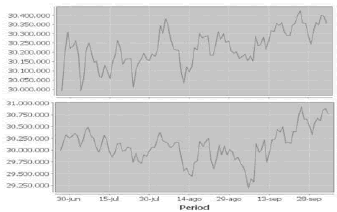
Figure 9. Portfolios values in COL$ of agents a1 (top) and a5 (bottom)
Here it can be seen that there were a lot of movement on such value of each agent. This is due to the fact that despite there was not too much movement in the actions of a1 for example, the market price of the stocks did had changes along the entire simulation.
Besides individual evolution of agents and stocks, the implemented prototype also allows visualizing comparative results. Figure 10 shows for instance, the stocks profitability and volatility, whereas Figure 11 shows investor agents profits.
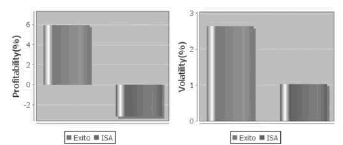
Figure 10. Stocks profitability and volatility
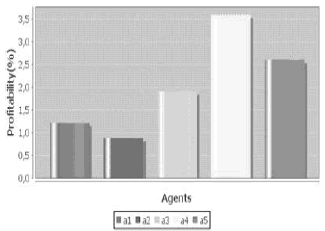
Figure 11. Investor agents profits
About Figure 11 it is important to stress that even though in this simulation run there seems to be a direct relation among agents risk tendency and the obtained profitability, this is not always the rule because it depends on market evolution.
6. CONCLUDING REMARKS AND FUTURE WORK
Traditionally, financial markets have been simulated and analyzed using methods that represent them at a very high abstraction level excluding some details about their constitutive parts. In contrast, and based on the experience and findings of other authors, a Multi-Agent Based Simulation - MABS model is proposed in this paper. Such approach considers the heterogeneity of each system component and sees overall system behavior as the emergent result of all the interactions among them, allowing the study of these markets complexity from another point of view.
In this proposal three kinds of agents were considered. Auctioneer agent who is in charge of managing the Continuous Double Auction mechanism, market agent who simulates external factors that affects price formation and supplies certain amount of orders with the aim at providing market liquidity, and finally investor agents who represent small, medium term, non-expert participants. We focused in the last one and particularly in how their reasoning mechanisms may affect their performances. In order to do that a fuzzy inference system was proposed which considers two agents' exogenous variables: stocks profitability and volatility, and one endogenous: their risk tendency. Such approach allows modeling buying and selling decisions in a human like manner considering general market conditions as well as individual factors which give to agents certain "personality". In addition to this, we also incorporated external human factors that may affect such decisions using probability values instead of booleans.
As validation of the proposed model, several simulations were made for the Colombian stocks market. Such simulations, one of them is summarized on this paper, lead us to some conclusions. The first one is that simulated market evolution seemed to be consistent (at least throughout a visual analysis) to real values used as input data for the prototype in terms of preserving basic statistical variables like mean and variance of the considered stocks. The second one is that, rather than concluding that there is a direct relation between profits and risk profile, it could be said that agents performance considering the proposed model (even when it could be said also for real life) depends utterly on market evolution.
There are some aspects that are planned as future work. One of these aspects is to incorporate agents with different kinds of reasoning, for example, one that uses technical indicators, one that uses forecasting methods, etc. Another aspect that we would like to analyze is the dynamic existence of agents according to global market evolution. For instance it could be simulated the incorporation of new investor agents when the existing ones are obtaining attractive profits.
REFERENCES
[1] DAVIDSSON, P. Agent based social simulation: a computer science view. Journal of artificial societies and social simulation, 5(1), 2002. [ Links ]
[2] WOOLDRIDGE, M. An Introduction to MultiAgent Systems. Chichester: John Wiley and Sons, 2002. [ Links ]
[3] VAN DER HOOG, S. On multi-agent based simulation. Working Paper, Center for Non-Linear Dynamics in Economics and Finance, University of Amsterdam, 2004. [ Links ]
[4] TESFATSION, L. Agent-based computational economics: growing economies from the bottom up. Artificial Life, 8(1), 55-82, 2002. [ Links ]
[5] IORI, G. A Microsimulation of Traders Activity in the Stock Market: The Role of Heterogeneity, Agents' Interaction and Trade Frictions. Journal of Economic Behavior and Organization, Vol. 49(2). 269-285, 2002. [ Links ]
[6] RABERTO, M. and CINCOTTI, C. Modeling and simulation of a double auction artificial financial market. Physica A, Vol 355. 34-45, 2005. [ Links ]
[7] COLLIE, M. J., DOWE, D. L. & FITZGIBBON, L. J. Stock Market Simulation and Inference Technique. In Proceedings of the Fifth International Conference on Hybrid Intelligent Systems, pp. 534-538, 2005. [ Links ]
[8] TAKAHASHI, H. and TERANO, T. Agent-Based Approach to Investors' Behavior and Asset Price Fluctuation in Financial Markets. Journal of Artificial Societies and Social Simulation, Vol. 6(3), 2007. [ Links ]
[9] LEBARON, B. Agent-based computational finance: suggested readings and early research. Journal of Economic Dynamics and Control, Vol. 24. 679-702, 2000. [ Links ]
[10] GROSSKLAGS, J & SCHMIDT C. Artificial Software Agents on Thin Double Auction Markets - A Human Trader Experiment. In Proceedings of the IEEE/WIC International Conference on Intelligent Agent Technology, 2003. [ Links ]
[11] HOFFMANN, A. O. I., DELRE, S. A., EIJE, H. J., and JAGER, W. Stock Price Dynamics in Artificial Multi-Agent Stock Markets. In Artificial Economics: Agent-Based Methods in Finance, Game Theory and Their Applications. 191-201. Heidelberg: Springer Verlag, 2005. [ Links ]
[12] DAS, R., HANSON, J. E., KEPHART, J. O. and TESAURO, G. Agent-human interactions in the continuous double auction. In Proceedings of the 17th International Joint Conference on Artificial Intelligence (IJCAI), San Francisco, CA, USA , 2001. [ Links ]
[13] YOKOO, M., SAKURAI, Y. and MATSUBARA S. Robust Double Auction Protocol against False-name bids. In Proceedings of the 21st IEEE International Conference on Distributed Computing Systems (ICDCS-2001), Phoenix, AZ, USA , 2001. [ Links ]
[14] WURMAN, P., WALSH, W., WELLMAN, M. Flexible double auctions for electronic commerce: Theory and implementation. Decision Support Systems, 24, 17-27, 1998. [ Links ]
[15] MORENO, J., VELÁSQUEZ, J. and OVALLE, D. Una aproximación metodológica para la construcción de modelos de simulación en el paradigma multi-agente. Avances en Sistemas e Informática, 4(2), 145-154, 2007. [ Links ]
[16] ESCOBAR, A., MORENO, J., MÚNERA, S. F. Modelo de simulación de una subasta de doble punta mediante el paradigma multi-agente. In Proceedings of the Fourth Colombian Computing Conference, (4CCC), Colombia , 2009. [ Links ]
[17] ZADEH, L.A. Fuzzy logic = Computing with words. IEEE Transactions on Fuzzy Systems, Vol. 4, pp. 103-111, 1996. [ Links ]
[18] ZADEH, L.A. Fuzzy Algorithms. Information and Control, Vol. 12, 94- 102, 1968. [ Links ]
[19] BVC. Colombian Stock Market. http://www.bvc.com.co. Accessed 1 June 2009. [ Links ]













